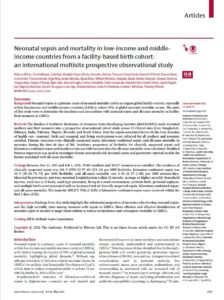
Background
Neonatal sepsis is a primary cause of neonatal mortality and is an urgent global health concern, especially within low-income and middle-income countries (LMICs), where 99% of global neonatal mortality occurs. The aims of this study were to determine the incidence and associations with neonatal sepsis and all-cause mortality in facility-born neonates in LMICs.
Methods
The Burden of Antibiotic Resistance in Neonates from Developing Societies (BARNARDS) study recruited mothers and their neonates into a prospective observational cohort study across 12 clinical sites from Bangladesh, Ethiopia, India, Pakistan, Nigeria, Rwanda, and South Africa. Data for sepsis-associated factors in the four domains of health care, maternal, birth and neonatal, and living environment were collected for all mothers and neonates enrolled. Primary outcomes were clinically suspected sepsis, laboratory-confirmed sepsis, and all-cause mortality in neonates during the first 60 days of life. Incidence proportion of livebirths for clinically suspected sepsis and laboratory-confirmed sepsis and incidence rate per 1000 neonate-days for all-cause mortality were calculated. Modified Poisson regression was used to investigate factors associated with neonatal sepsis and parametric survival models for factors associated with all-cause mortality.
Findings
Between Nov 12, 2015 and Feb 1, 2018, 29 483 mothers and 30 557 neonates were enrolled. The incidence of clinically suspected sepsis was 166·0 (95% CI 97·69-234·24) per 1000 livebirths, laboratory-confirmed sepsis was 46·9 (19·04-74·79) per 1000 livebirths, and all-cause mortality was 0·83 (0·37-2·00) per 1000 neonate-days. Maternal hypertension, previous maternal hospitalisation within 12 months, average or higher monthly household income, ward size (>11 beds), ward type (neonatal), living in a rural environment, preterm birth, perinatal asphyxia, and multiple births were associated with an increased risk of clinically suspected sepsis, laboratory-confirmed sepsis, and all-cause mortality. The majority (881 [72·5%] of 1215) of laboratory-confirmed sepsis cases occurred within the first 3 days of life.
Interpretation
Findings from this study highlight the substantial proportion of neonates who develop neonatal sepsis, and the high mortality rates among neonates with sepsis in LMICs. More efficient and effective identification of neonatal sepsis is needed to target interventions to reduce its incidence and subsequent mortality in LMICs.